
Nothing beats the joy of sitting down with a great board game. So, it’s a good thing that over the years, companies like Milton Bradley and Parker Brothers – as well as smaller, more independent firms – have released increasingly inventive, complex and fascinating titles to cater for anyone with a mind for competitive play. Today, then, the variety of board games out there is stunning, with everything from card-based fantasy epics to strategy-oriented economic brain busters available to pick up from store shelves. And among them, of course, are some genuine classics.
With this in mind, the following list article profiles the 30 best board games in the history of the medium, whether they be family favorites that have endured through the decades or more recently released table-top triumphs. In any event, each of these titles is in its own way a must for any serious enthusiast’s collection.
Methodology
To develop this list, we first examined online opinion about the board games currently available on the market. In particular, we studied both crowd-generated and expert rankings of board game titles. These rankings were as follows:
• BoardGameGeek’s board game rankings
• Ranker, “The Best Board Games Of All Time”
• Board Gamers Anonymous, “Top 100 Board Games Of All Time”
• RaveReviews.org, “Best Board Games of All Time”
In order to determine which games to include, we took into consideration both how frequently they appeared on the above lists and where exactly they placed. However, the key metrics behind this were the opinion and acclaim of both individual expert gamers and gaming fans more generally.
The ordering was achieved by analyzing the rankings of the aforementioned lists of the best board games, with the data then crunched to create our own definitive top 30. Other indicators of popularity, such as units sold and the number of new editions and expansion packs, were also considered in the final reckoning.
It’s additionally worth noting that we wanted the list to have a modern feel while also encompassing titles that are either family-friendly, championed by board games enthusiasts or both. For the former two reasons especially, then, we chose to omit classic board-based strategy games such as chess, checkers and Go.
Incidentally, for those wondering why famous titles like Monopoly were not included, there’s a simple explanation: they didn’t figure highly enough on the lists used to compile rankings, so even after adjustments they didn’t make the top 30.
30. The Game of Life
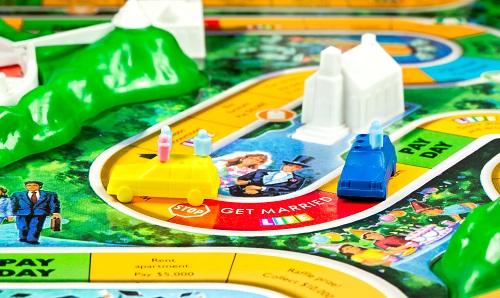
There are few names in board games as influential as Milton Bradley, and the gaming pioneer’s empire began with his now-famous The Game of Life. First brought into being as The Checkered Game of Life in 1860, Bradley’s original vision was somewhat different to the focus of the title we know and love today. That said, its main aim – sending players on a journey through education, work and retirement – remains the same today. And a century on, the publisher’s prosperous company released a modern update, including the now-familiar spinning wheel and a 3D playing board. The current version of The Game of Life furthermore continues to stand the test of time more than 15 decades on from its conception. Indeed, the cherished title has sold in excess of 30 million sets, according to figures from 2015.
29. Dominare
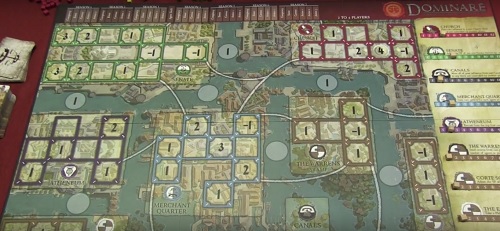
While many strategy games focus on the efforts of heroes, Dominare has a rather more Machiavellian set of characters. Released by Alderac Entertainment Group in 2012, the strategy-focused title puts players in charge of scheming masterminds trying to gain control of the city of Tempest from within its shadows. Through a variety of options available, competitors attempt to spread influence throughout the metropolis as they climb closer to the ultimate seat of authority. In addition, intense planning and suitable management of resources – such as assassins and other political conspirators – are needed in order to gain an advantage. But staying ahead isn’t simple, as the game can provide many last-minute surprises, while it also fosters a balance of power that is easy to tip over. Difficult yet rewarding, Dominare has all the hallmarks of a modern classic.
28. Arcadia Quest
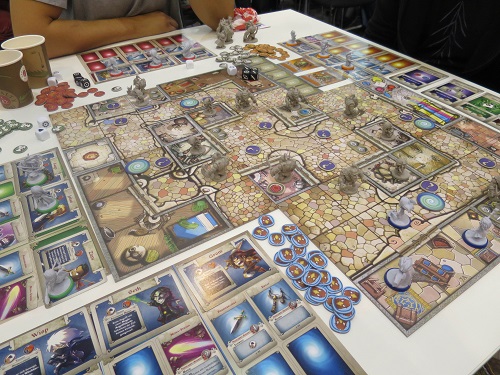
Throughout the fantasy board game genre, play has often revolved around the classic premise of good versus evil. However, in CoolMiniOrNot’s 2014 release Arcadia Quest, things aren’t quite so black and white. True, combatants are all on a mission to slay a vampire lord, but the dice-based game is by no means meant solely for co-operative play. Indeed, victory is only possible by defeating rival guilds in battle. Arcadia Quest’s dog-eat-dog theme is complemented by a vivid board and detailed miniatures which become even more impressive when considering the fact that the title originated on Kickstarter. It also features accessible mechanics – with moves mainly determined by dice rolls – and has spawned a multitude of expansions within only three years of first going on sale.
27. King of New York
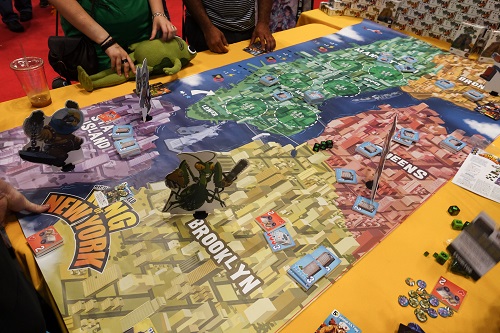
Seemingly inspired by monster movies like Godzilla and King Kong, King of New York puts players in the mighty feet of giant city-smashing kaiju, and the results are even more fun than this suggests. The 2014 release is based on designer Richard Garfield’s 2011 title King of Tokyo but, as its name suggests, moves the action to the United States. Here, competitors must earn points by destroying buildings, fending off the military and doing battle with their opponents until only one remains as victor. In addition, gamers can make use of a new “fame” mechanic – a feature that grants additional points based on monsters’ growing infamy amid the Big Apple. Perfect for kids and grown-ups alike, this two-to-six-player IELLO-released hit features a whole host of zany characters and wildly imaginative scenarios. Most importantly, however, it lets fans revel in experiencing life from monsters’ points of view.
26. Sorry!

Most games require at least some element of competition; however, Sorry! takes this to another level entirely. Throughout proceedings, each player must not only move their four pieces to a home square through a series of card draws but also do their best to knock their opponents’ pawns back to the start of the board – hence the apologetic title. Having first originated in England in the early 1930s, Sorry! gained a wider release when it was picked up by Parker Brothers for American distribution in 1934. And though its cutthroat mechanics have surely led to many arguments, this classic remains a popular title for family game nights. Over time, meanwhile, Sorry! has been supplemented with alternative rules that suggest a more strategically minded tournament play system. Editions tied in to classic TV series The Simpsons and popular movie Spider-Man 3 have additionally been launched.
25. Dominion
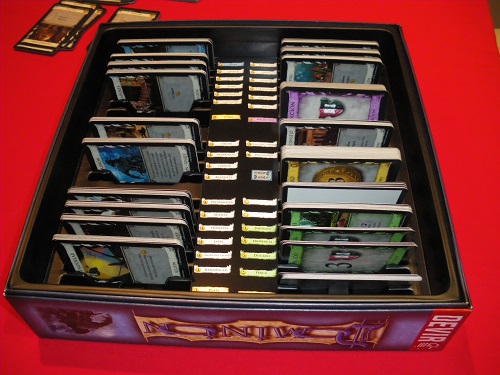
Though it’s still less than ten years old, Dominion has already made a substantial mark on the gaming community. And the medieval-era card game differentiated itself from its peers from the start by making competitors construct their decks throughout a session as opposed to at the start of play. As a result, the Rio Grande Games product sowed the first seeds of the deck-building genre and led to other notable titles such as Legendary Encounters and Shadowrun: Crossfire. What’s more, the brainchild of Donald X. Vaccarino is still a much-loved title among fans of the style years after its 2008 debut, thanks in part to its focus on empire building and mechanics that even those new to the series will be able to master. The 500 cards that come with the original Dominion box set offer many avenues for play, too, ensuring that fans are unlikely to act out the same scenario twice.
24. Trivial Pursuit
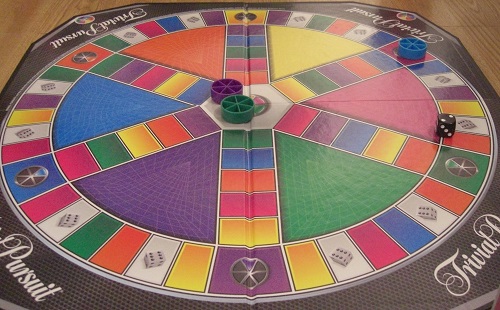
Trivial Pursuit, which famously mixes quiz elements with the set-up of a traditional board game, has been a hit with families the world over since its launch in 1981. Developed by Chris Haney and Scott Abbott and originally brought to the mass market by Selchow and Righter, the title requires players to get around and ultimately to the center of the board using the roll of a die. Sounds simple, right? Well, not exactly. You see, those in the game must show off their general knowledge skills to keep moving and can only complete it once they’ve successfully answered questions in six different categories – like Entertainment and Science & Nature – and collected six corresponding colored wedges. Though only 1,100 copies were released in its first year on sale, Trivial Pursuit has gone on to become one of the world’s most successful board games. Indeed, the trivia tester has sold 100 million sets and spawned over 50 varying editions, which challenge its players on a variety of more specialized subjects.
23. Carcassonne
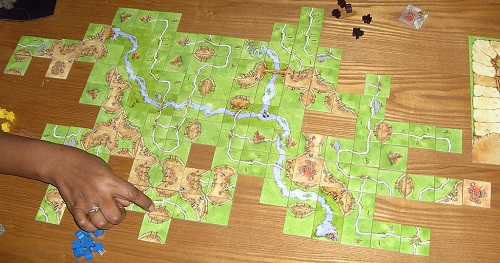
An unfinished game board may be cause for some players to head right back to the store for a refund, but Carcassonne’s incomplete layout is all part of the family-friendly territory-builder’s charm. Throughout each round, up to five people have to lay out tiles on the table to create a unique and enchanting medieval landscape, inspired in part by a real-life town in latter-day France. Competitors must rely on cunning tactics to snatch victory from their opponents’ grasp through the acquisition of roads, cities and monasteries, and once all the tiles have been laid, points are tallied up and the game is complete. Carcassonne has also allowed developer Klaus-Jürgen Wrede – working with publisher Z-Man Games – much room for expansion, and he has designed several new addition packs since its first instalment hit shelves in 2000.
22. Mice and Mystics
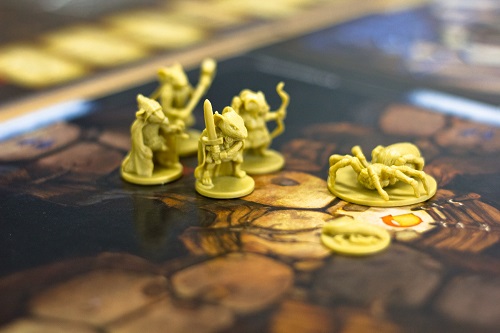
Somewhat unusually, Mice and Mystics tells its tale from the point of view of our rodent friends. That’s right: this co-operative game thrusts players into the roles of heroic mice who must take part in a series of epic quests. However, while the concept may seem like a gimmick at first, Mice and Mystics actually rises above its novel premise through some impressive and absorbing storytelling. Furthermore, its characters are cute enough to appeal to younger gamers and might just act as a gateway for new legions of fantasy fans. Developed by Jerry Hawthorne and published in 2012 by Plaid Hat Games, Mice and Mystics can support up to four dedicated adventurers at a time. Meanwhile, its subsequent five expansions guarantee that players won’t be running short on stories to engage with any time soon.
21. Ticket to Ride
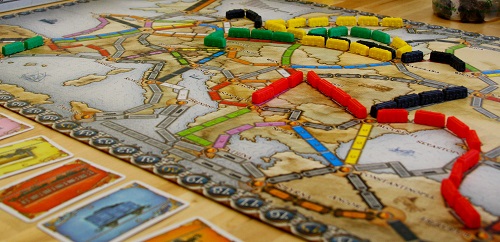
While its name may make it sound like a board game adaptation of The Beatles’ greatest hits, Ticket to Ride is actually an enthralling adventure through North America’s railroads. Along the way, players must lay claim to certain rail routes and compete in fierce business battles as they aim to hold command of the longest road among them. But although Ticket to Ride’s gameplay may be addictive and competitive, its real charm lies in how easy it is to pick up. According to the designer, Alan R. Moon, in his title’s original 2004 press release, “The rules are simple enough to write on a train ticket.” And it could be this aspect that has made it a hit with people around the world. In fact, Ticket to Ride’s popularity is such that publisher Days of Wonder has sold more than three million copies to date and released new versions for different countries and continents.
20. The Castles of Burgundy
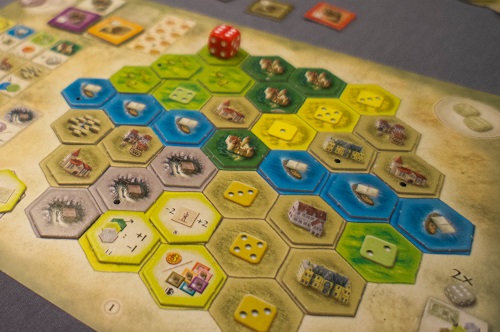
Set amid the feudal realms of medieval France, The Castles of Burgundy possesses some similarities to fellow dice-based territory-building games. For instance, as with other examples of the genre, this Eurogame’s objective is to earn victory points, which here players can collect by acquiring settlements and selling goods. However, The Castles of Burgundy really shines thanks to an unusual mechanic that makes competitors roll their dice before they’ve even started a round. This allows for greater forward planning on each player’s part as well as monumental degrees of adaptability – especially if a settlement they’ve been eying all through their opponent’s round gets snapped up at the last second. Made with two to four people in mind, The Castles of Burgundy has been wowing audiences since its release by Alea/Ravensburger in 2011. Its success has even led to a card-based spin-off in 2016 not to mention seven expansion packs to date.
19. Apples to Apples
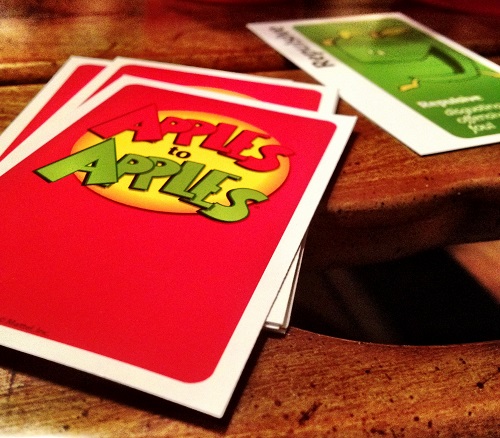
Although many of the titles on this list require strategy, skill and forward planning for success, all that Apples to Apples asks of its players is a great sense of humor. And rather than setting competitors a complex quest to complete, the game – which was originally released by Out of the Box Publishing in 1999 – instead presents them with a variety of “description” and “thing” cards. Each player must then in turn match a “description” card with an appropriate – or, in some cases, inappropriate – “thing” card from their own hand to create often absurd and hilarious phrases. Subsequently, an appointed judge will choose the most fitting or side-splitting pairing from each round and award a point to that player. That simple set-up plus the potential to accommodate as many as ten people at a time mean that Apples to Apples is the perfect game to bring out at parties. It even earned plaudits from Mensa upon its first year of sale and would pave the way for the similar – albeit far filthier – Cards Against Humanity.
18. Suburbia
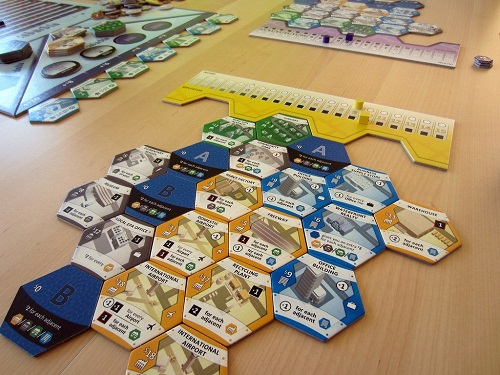
Bézier Games release Suburbia introduces players to the world of city planning and town management. The tile-building game sees up to four opponents racing to create the largest town and secure the highest population of residents. But the path to victory isn’t as simple as merely buying enough property and living space. Rather, opponents find themselves vying for both reputation and income, and their actions in pursuit of one goal may prove detrimental to another. For example, although factories will increase a city’s wealth, they could also drive away potential residents if placed too close to houses. Consequently, success in Suburbia is a balancing act – and yet its tricky yet thought-provoking play has kept people hooked since it first hit shelves in 2012. No doubt bolstering its popularity, in addition to the standard board, two expansion packs are available, which add further rules and challenges for those who have got to grips with the original and want more.
17. Stratego
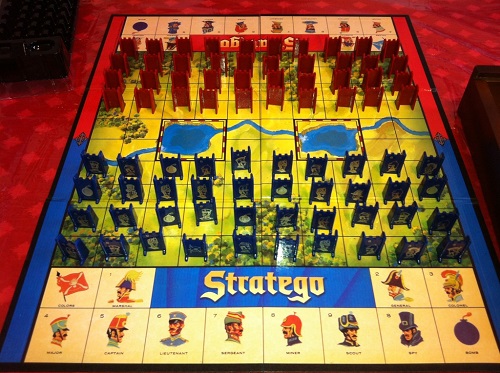
Stratego is said by some to have its origins in an early-20th-century French game called L’Attaque, but it wasn’t until Milton Bradley released an English-language version decades later that it reached U.S. audiences. Much like chess, the military-themed tabletop title takes place over a tiled board and requires two players and a number of pieces. Unlike that time-honored game, however, Stratego introduces tactical elements into the fray in the form of bombs, which forces individuals to think of meticulous and varied ways to both defend their troops and given flag and still be able to go on the attack. Stratego has gone on to sell millions of copies all over the United States and has appeared in multiple forms throughout the years. A 21st-century re-release, for example, featured fewer game pieces, while other companies, including Marvel, have also lent their licenses to its name.
16. War of the Ring
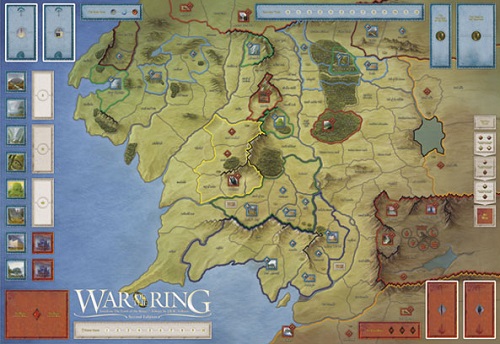
While there have been many board games released under the Lord of the Rings name, there could only ever be one to rule them all. Originally produced by Fantasy Flight Games, War of the Ring transports the willing to Middle-earth and pits one player as the heroic Free Peoples against the other as the evil Shadow Armies. Allowing fans to live out set pieces from their favorite fantasy series is enough of a gift, but this dice-based wargame further rewards combatants with the different paths available to each challenger. Moreover, those operating as the Free People are encouraged to seek another avenue to success besides military victory – namely, the quest to submit the one ring to its fiery fate on Mount Doom. War of the Ring won multiple awards after its initial 2004 release, and seven years on from it hitting the market, it received an expanded Ares Games re-release that added new rules and improved game pieces.
15. Battleship
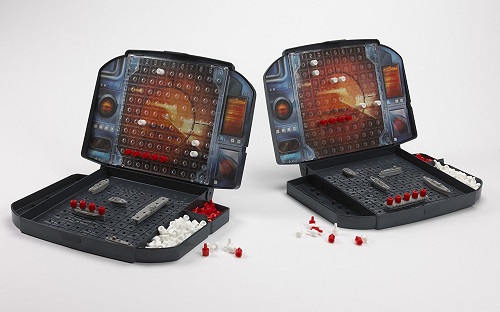
Battleship’s pegs and pieces may be an iconic part of gaming history, but the military-themed guessing game actually started life in a much more simplistic fashion. When it was introduced in 1931 under the name Salvo, the two-person game was actually played with pencil and paper. In fact, it wasn’t until Milton Bradley’s acquisition of the product that the opposing plastic boards were introduced in 1967. Yet while Battleship’s look may have changed, its rules have stayed faithful to the original concept nearly a century after its first published version came onto the market. And Battleship’s fun and easy-to-learn mechanics – which involve a player guessing the location of their opponent’s concealed vessels – have helped it acquire a longevity and cultural influence beyond that of other board games. Indeed, it even inspired a 2012 blockbuster action film.
14. Love Letter
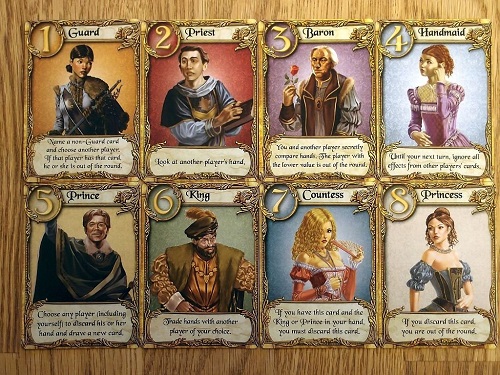
For board game players who are lovers rather than fighters, Love Letter is ideal. Still, there’s an element of combat within the family card game – which was originally published by Alderac Entertainment Group in 2012 – as it sees individuals competing against one another to earn a princess’ affection. To do this, each challenger must knock out their rivals through a process of elimination until they remain the sole suitor left in play. Love Letter caters for up to four opponents at a time and is relatively easy to get to grips with. Better still, once the original version has been enjoyed to its full, there are spin-offs and adaptions waiting in the wings – among them a tie-in with TV spy comedy Archer and a somewhat bizarre horror-themed H.P. Lovecraft edition.
13. Defenders of the Realm
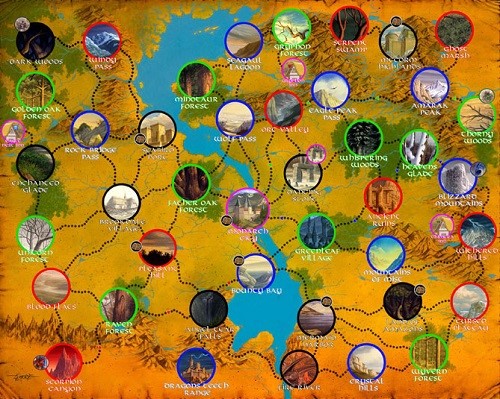
Whereas most board games pit player against player, Defenders of the Realm has a more co-operative approach. Yes, this fantasy game – published by Eagle-Gryphon Games in 2010 – lets as many as four individuals team up in a quest to save their kingdom from the forces of darkness. Through a mix of dice rolling and card management, each must do battle with demons and dragons while making good use of their teammates’ skills in order to achieve success. Defenders of the Realm is a great buy for any gaming fanatic with an interest in Tolkien-esque environments, featuring as it does classic fantasy characters and beings like orcs, wizards and dwarfs. And although the box says it’s only suitable for those aged 13 or over, its emphasis on teamwork and collaboration makes it highly playable for families of all ages. Perhaps as a result of this, Defenders of the Realm has been sold to thousands of households the world over.
12. Blood Rage
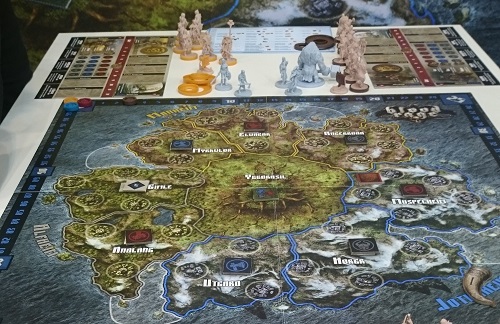
Born out of a successful Kickstarter campaign in 2015, Blood Rage is a game entirely deserving of its fearsome title. The card-based strategy newcomer is set at a time when the world is coming to an end and sees up to four people assume the role of Viking clans fighting for a place amongst the gods. The gameplay duly involves its fair share of mayhem, carnage and testosterone-fueled intensity, as combatants take part in battles and conquer lands with “rage” as their only resource. Naturally, it isn’t appropriate for younger children – and that’s not just down to Blood Rage’s mature themes. In addition, throughout each game players must learn to utilize various strategies which can in turn be countered by their opponents’ conflicting plans, giving it quite the layer of complexity. Since Blood Rage’s debut, it has picked up prestigious nominations at both the Golden Geek Awards and SXSW Gaming Awards.
11. Roll for the Galaxy
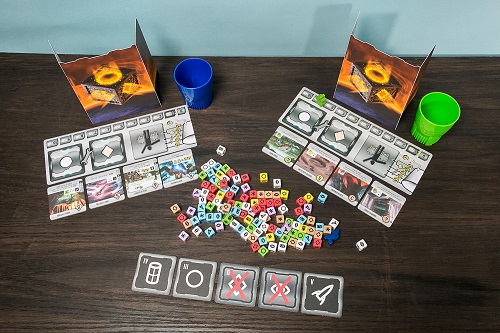
Developed from the equally addictive Race for the Galaxy, Roll for the Galaxy – as the name implies – swaps its originator’s card-based action for outcomes that hinge on the roll of a die. But what makes this game special is the sheer number of dice required to keep things in motion: a total of 111 are shared between two to five individuals and are used by each gamer in their attempts to establish their own space empire. For example, during each round a player will use the outcome of their dice roll to develop their strategy, which may involve exploring planets, shipping items or strengthening their own infrastructure. Developed by Thomas Lehmann and Wei-Hwa Huang for Rio Grande Games and then released in 2014, Roll for the Galaxy has arguably fared even better than its card-using counterpart. It received an expansion named Ambition in 2015, while Lehmann announced a second expansion, called Rivalry, in April 2017.
10. Clue
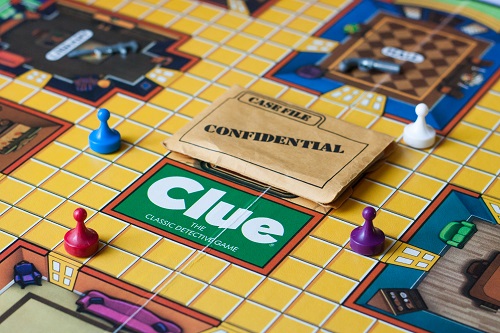
Last time my mom came to town, she brought a stack of old board games. Here’s a version of Clue, “The Classic Detective Game” from Parker Brothers, from the early 1980s.
While working as a legal clerk in 1944, Anthony E. Pratt changed the history of board games forever when he attempted to patent his idea for a now-classic whodunit. Then five years later, Pratt saw his brainwave become a reality when Parker Brothers published the now-iconic Clue, a.k.a. Cluedo. Each taking on the role of a different detective, competitors must ascertain the identity of a killer from a range of gloriously colorful characters – like Colonel Mustard and Professor Plum. The would-be sleuths also have to pick out the murder weapon and killing location, and it’s all done using a process of trial and error. Despite its somewhat macabre premise, the game has been a hit with audiences of all ages ever since its release and even inspired a movie adaptation in 1985. That being said, Clue has changed over the course of the nearly 70 years it’s been in service. In particular, a 2016 overhaul by current publisher Hasbro offed the beloved character Mrs. White for good.
9. Agricola
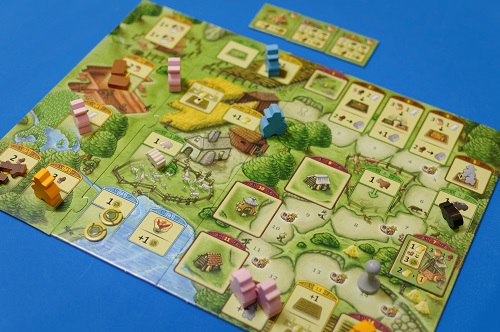
Many board games transport their players to fantastical realms; Agricola’s setting, however, is a little more prosaic. That’s because the worker placement game – developed by Uwe Rosenberg and published in 2007 by Lookout Games – sees up to five individuals each taking on the role of a different farmer and his wife as they build up their homesteads over time. But despite the simplistic charm of its premise, Agricola is anything but easy. In fact, competitors are met with fairly punishing odds right from the very start of play, while a forward-thinking approach and a mastery of multiple strategies is paramount in order to ensure victory. Small wonder, then, that the game is very much intended for players aged 12 or above, although it also exists in a beginner’s version that makes it more accessible to younger audiences. At any rate, Agricola has since succeeded both critically and commercially. At least 50,000 sets were purchased worldwide in 2007 and 2008 alone, while it has also subsequently picked up multiple awards.
8. Caverna: The Cave Farmers
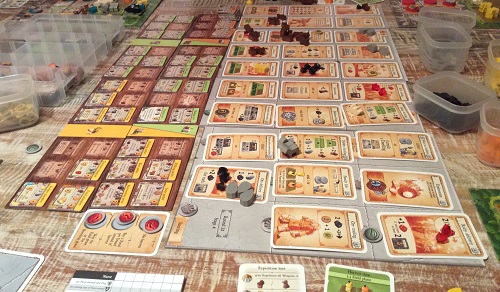
Released in 2013 by Lookout Games and developed by the man behind Agricola, Caverna: The Cave Farmers maintains its predecessor’s focus on building farms. However, while those in the game are still required to build up their farmsteads to succeed, they can also mine their surrounding mountains, engage in additional quests and arm their caves’ inhabitants along the way. Caverna also distinguishes itself from creator Uwe Rosenberg’s previous venture by placing less of an emphasis on card decks. In addition, it comes with a fairly hefty price tag – as much as $90 in some quarters. But the strategy game remains popular, with BoardGameGeek users even rating it as one of the top ten titles of its kind currently available on the market. Perhaps Caverna’s success is down to both its complex mechanics and the fact that it supports solo play as well as room for up to seven competitors.
7. Catan
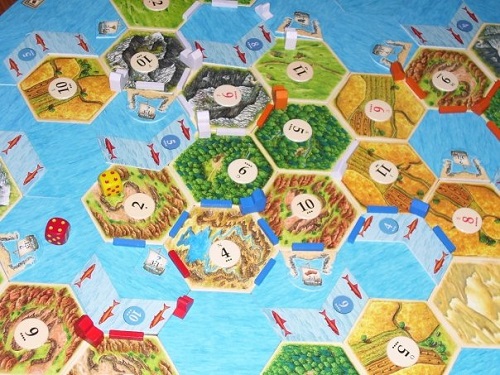
Catan – previously known as The Settlers of Catan – was four years in the making, but it was easily worth the wait. And the care and attention that designer Klaus Teuber put into his product seems to have paid off, as it’s since been acclaimed as a “masterpiece.” Set on the fictional island of Catan, the game sees competitors take turns to vie over resources and build superior and dominating settlements. Unlike with many strategy games, though, Catan’s various ways of clocking up those all-important victory points mean that those of practically all ages and levels of experience can play together without anyone in particular being assured of triumph. Perhaps that goes some way to explaining why Catan has sold an incredible 22 million copies since its 1995 release by publisher KOSMOS and has introduced many English-speaking players to German games. Impressively, too, on top of its expansion packs, Catan has been honored with its own video games, a novel and even a planned movie adaptation.
6. Puerto Rico
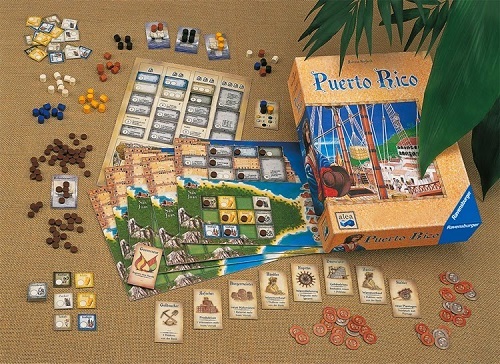
While Puerto Rico’s setting may transport players to a Caribbean paradise, its complex mechanics mean that it’s far from a vacation for the brain. Nevertheless, the economy-based strategy game is a riveting take on the cutthroat business practices of the colonial era. Created by designer Andreas Seyfarth and released in the English-speaking world in 2002 by Rio Grande Games, Puerto Rico requires up to five players in total to earn victory points by cultivating crops, amassing property and transporting goods throughout the colonies. However, its rules – including a variable phase order mechanic which continually alters each person’s turn – ensure that gamers remain on edge throughout and are continually adapting their tactics and implementing new strategies. Thanks to Puerto Rico’s popularity, Seyfarth would develop successor San Juan in its wake.
5. 7 Wonders
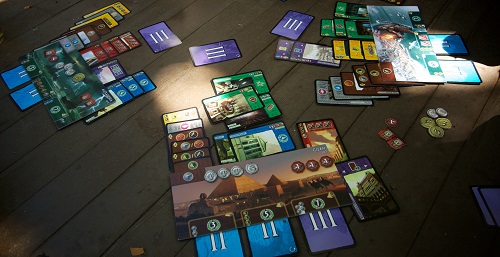
Repos Production’s 7 Wonders is a modern classic – but one that takes players back to an age of myths and marvels. Set in the period of classical antiquity, the historical card development game sees up to seven combatants vying for power in the ancient world by expanding cities, securing resources and growing their armies. Throughout the course of three rounds, or “ages,” each competitor must play and send on a total of seven varieties of cards, including military and science types, and collect the highest number of “victory points” to win. Since its 2010 release, 7 Wonders has garnered acclaim from sections of the gaming community thanks to its striking design and addictive gameplay. In addition, it has earned numerous awards – including both the Golden Geek Awards’ Best Family Board Game and Best Card Game honors in 2011 – and spawned six expansion packs.
4. Power Grid
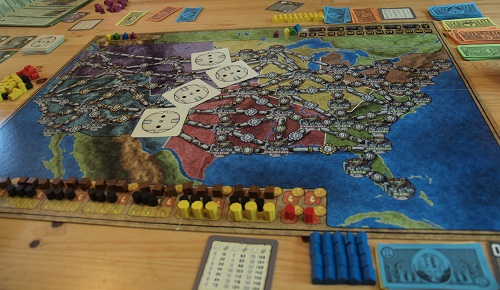
Based on German designer Friedemann Friese’s 2001 release Funkenschlag, Power Grid transports the original version’s energy-centered gameplay to North America. Using a board that depicts the United States, a total of six people must create power supply networks, buy power plants and manage various resources such as coal and uranium. But while the premise may seem simple, this strategy game features various complex avenues to victory or defeat. For example, buying new power plants may seem like an easy way to win, but doing so will allow opponents the chance to purchase yet more powerful facilities. Since its 2004 re-release by Rio Grande Games, Power Grid has proved an enormous success worldwide. Throughout the years, in fact, it has been repackaged to feature countries from China to Italy and earned itself sales in at least the tens of thousands.
3. Risk
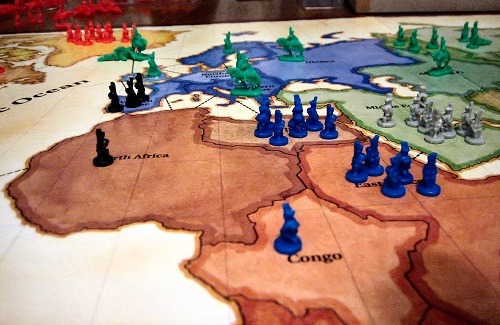
After being first released in the U.S. by Parker Brothers in 1959, Risk has enjoyed over 50 years as the world’s premier war game. Through its classic “fight to the death” scenario, it lets up to six players fight it out over 42 traditionally real-world territories in a bid to hold control of the biggest empire. To do so, combatants must enforce and expand their borders by building up armies and strike hard against their opponents until only one colony is left on the board. Risk famously has ultra-competitive and demanding play; it’s so punishing, in fact, that Playboy magazine even ran a strategy guide for it in the 1970s. Nevertheless, Risk remains a staple of any gaming enthusiast’s collection and continues to find new audiences through various special editions, including Star Wars-, Lord of the Rings– and Game of Thrones-themed sets.
2. Small World
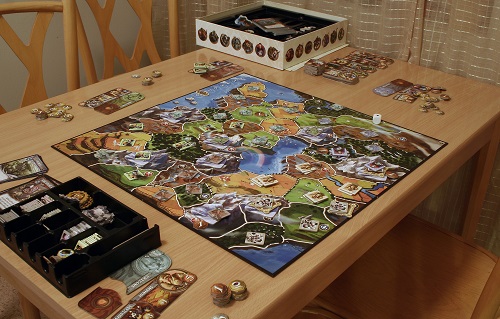
Family-oriented fighting games may be relatively rare, but Small World suggests that they can be done – and done well to boot. Like similarly themed classics such as Risk and Catan, the game sees players trying to build up empires and advancing their armies across the board to this end. However, what differentiates it from other benchmarks is the sense of fun that designer Philippe Keyaerts has brought to the title, with its colorful world and vibrant characters – which include wizards, giants and orcs – all adding to its feeling of whimsy and delight. And although Small World was initially meant as a mere sequel to Keyaerts’ previous Vinci, it has arguably taken on a life of its own. Certainly, it’s garnered acclaim: the 2009-published Days of Wonder title was named Games magazine’s Game of the Year in 2010, and it even made history as the first board game ever to be released in an iPad version.
1. Pandemic
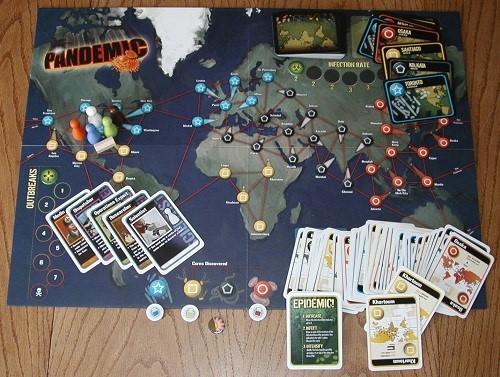
Designed by Matt Leacock for Z-Man Games and originally released in 2008, Pandemic takes its inspiration from world health crises and puts competitors in charge of curing several life-threatening diseases. Mixing family-friendly co-operative play with strategic elements, the game forces competitors to make difficult choices with each turn. For example, they can either work towards building research centers and devising antidotes for the series of four plagues, or they can aid infected citizens in certain locations and stop sickness from venturing further afield. What makes Pandemic even more compelling is an enforced time limit that effectively ends the game if players – of which up to four are supported – allow any of the illnesses to escalate out of control. And its alarming concept didn’t stop it picking up both Games magazine’s 2009 Best New Family Game award and, the previous year, JoTa’s Best Cooperative Board Game honor.
